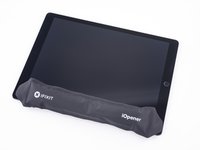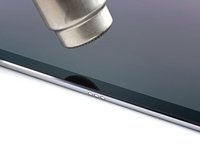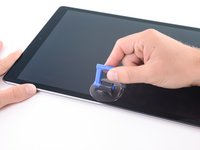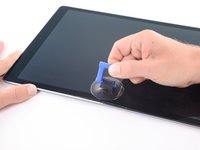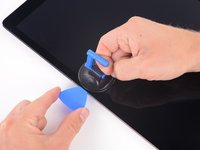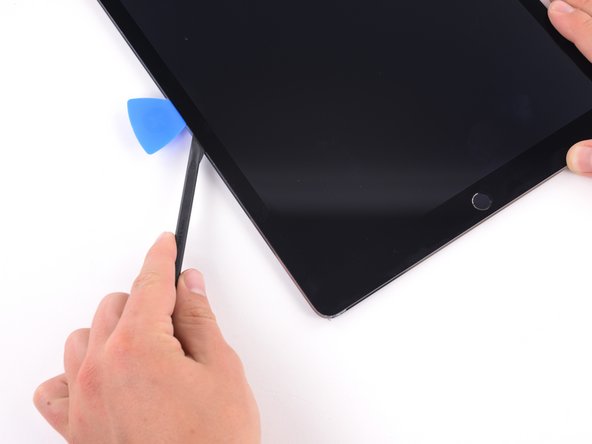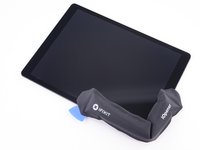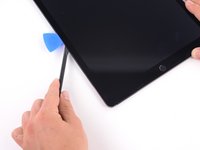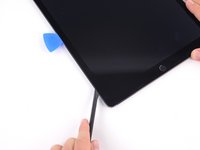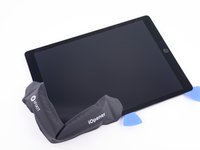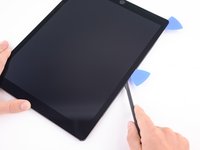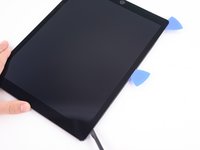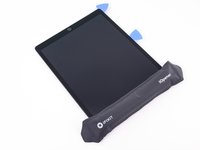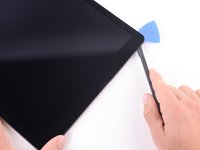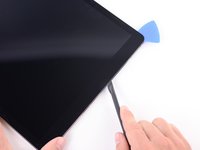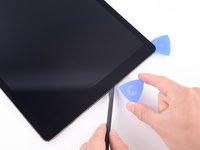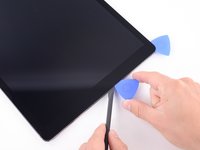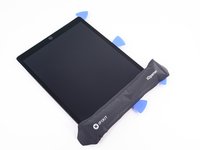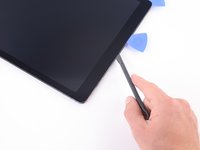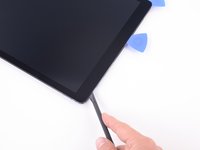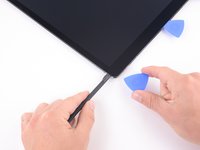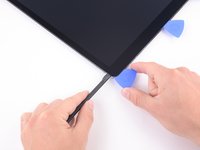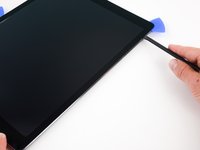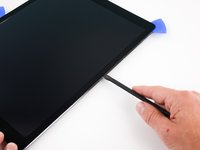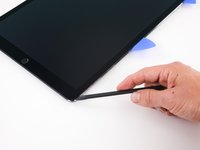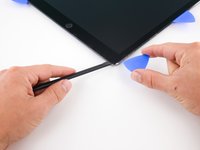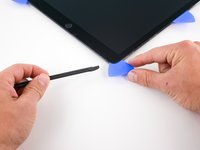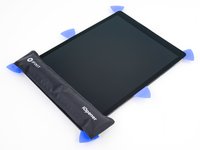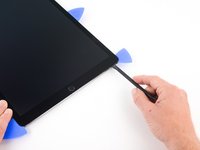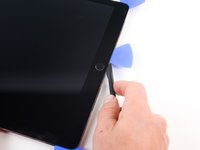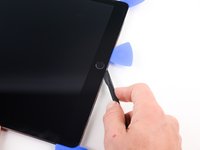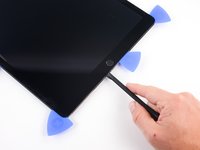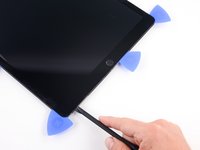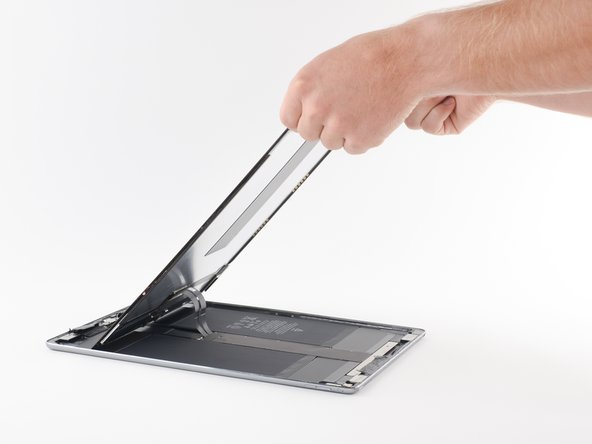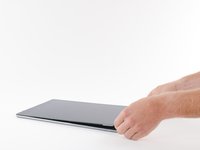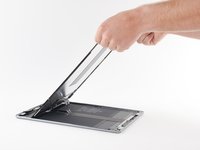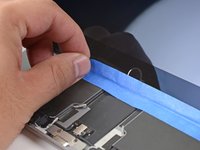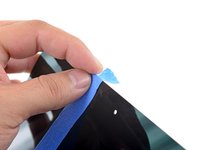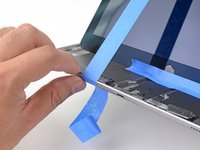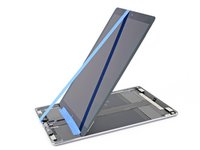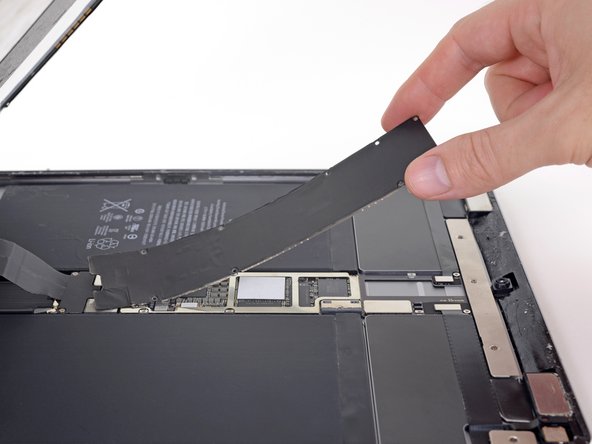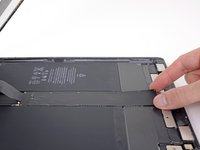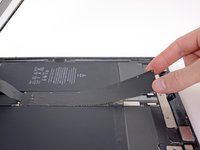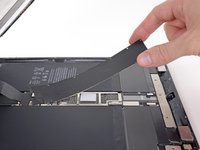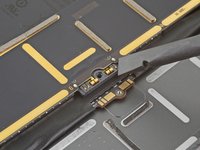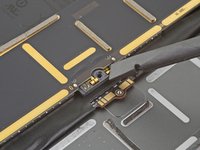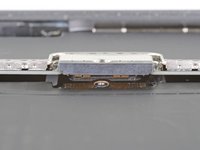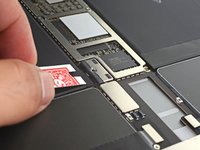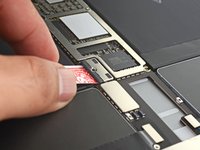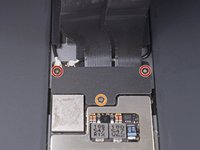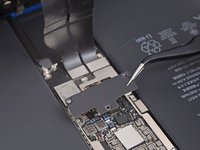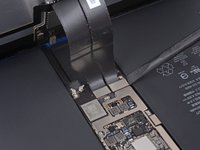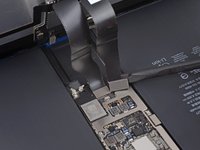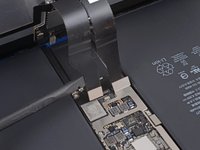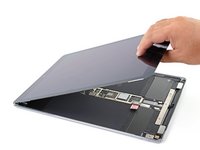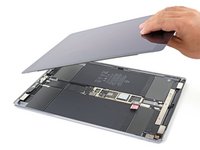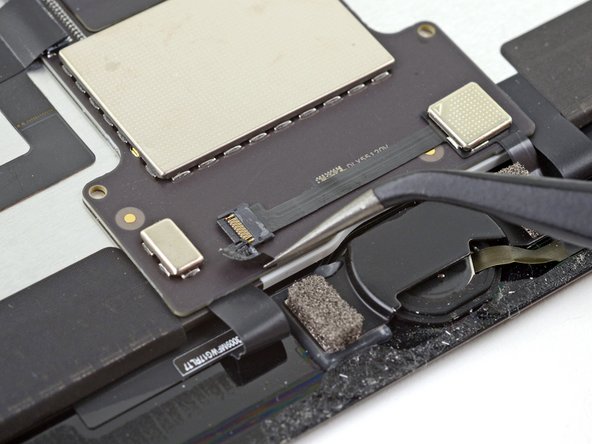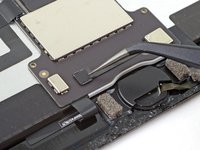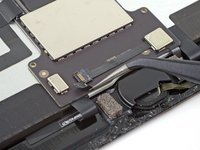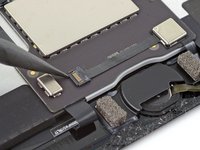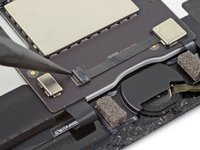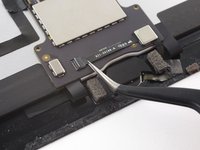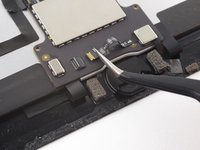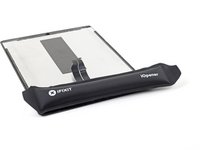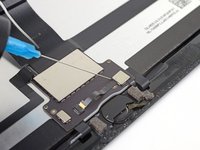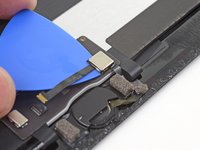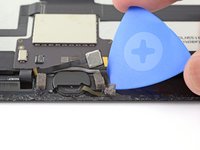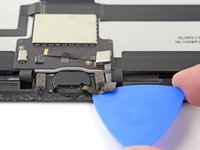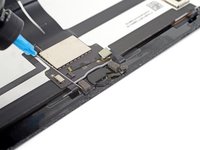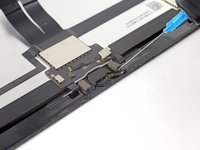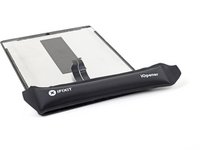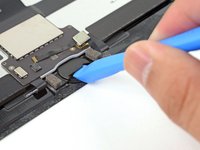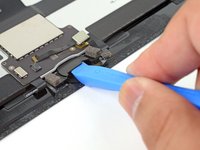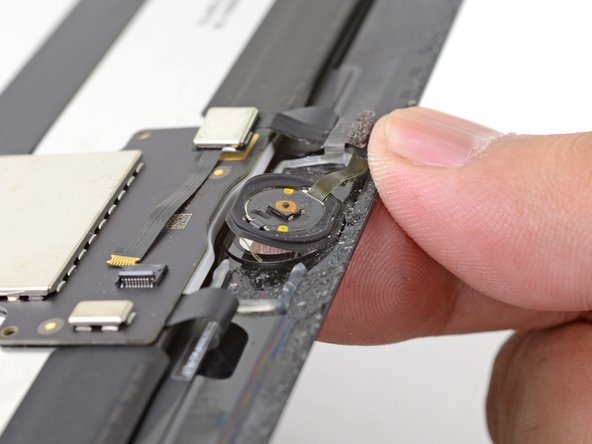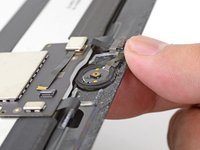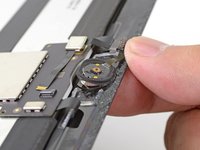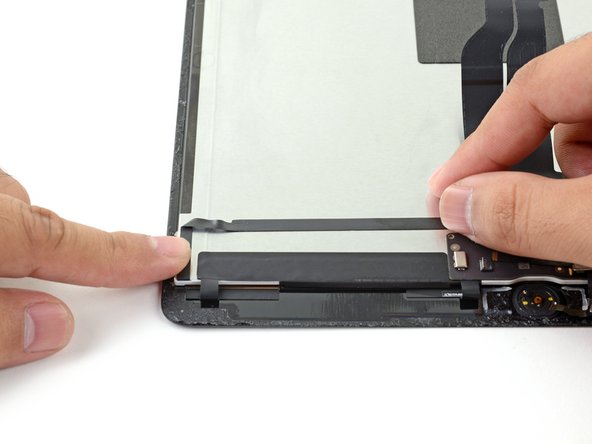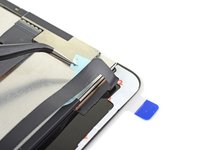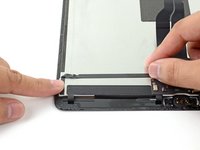Introduzione
Segui questa guida per sostituire lo schermo di un iPad Pro 12,9" o per accedere ai componenti interni per ripararli.
Ricordati che il tasto Home del tuo schermo originale è associato alla scheda madre dell'iPad e richiederà di essere rimosso e trasferito sul nuovo schermo per mantenere le funzioni del Touch ID.
Prima di iniziare controlla se il tuo nuovo schermo ha la scheda figlia attaccata sul retro. Se è così, potrai seguire questa guida. Altrimenti dovrai trasferire la scheda dal vecchio schermo al nuovo. Il trasferimento della scheda richiede un equipaggiamento specifico per le microsaldature, quindi consigliamo agli utenti fai-da-te di cercare uno schermo che abbia già la scheda piuttosto che provare a trasferirla.
Alcune immagini nella guida sono state scattate per un modello WiFi e quindi ci sono differenze visive rispetto al modello LTE. La procedura è la stessa per entrambi i modelli, salvo dove segnalato con delle note.
Stai molto attento quando isoli la batteria usando un blocco per batterie. I contatti della batteria si danneggiano facilmente, risultando in danni irreversibili. Se decidi di seguire la guida senza isolare la batteria, evita di usare qualsiasi strumento in metallo se non quando strettamente necessario (come quando sviti le viti) per evitare di far fare corto circuito alla batteria e danneggiare dei componenti delicati.
La procedura di apertura per questo iPad Pro mostra l'utilizzo di uno spudger Halberd. Se non ne possiedi uno, puoi usare un plettro di apertura: il procedimento è lo stesso.
Cosa ti serve
-
-
Spegni completamente il tuo iPad prima di iniziare
-
Stendi strisce di nastro da pacchi trasparente sovrapposte sullo schermo dell'iPad finché non è coperta tutta la superficie.
-
Fai del tuo meglio per seguire il resto della guida come descritta, ma, una volta che il vetro è rotto, è molto probabile che si continuerà a rompere mentre lavori e potresti avere bisogno di usare uno strumento per fare leva per rimuovere i pezzi di vetro.
-
-
-
Mentre tagli l'adesivo, considera quanto segue:
-
La parte superiore ha una zona ampia di adesivo spesso. Dovrai tagliare a una profondità di 1,2 cm per separare l'adesivo.
-
Non tagliare a più di 2 mm di profondità sui bordi dell'iPad o rischierai di danneggiare il pannello dello schermo.
-
Anche il bordo inferiore ha delle zone con l'adesivo più spesso, ma ci sono dei delicati cavi flessibili in entrambi gli angoli. Non tagliare più in profondità di 6 mm intorno agli angoli inferiori.
I have an A1652 iPad pro 12.9” that was originally my wife’s. The battery doesn’t hold a charge very long in use so I read through this guide and ordered the kit and battery. This iPad has a gold colored case that appears to wrap over the edges of the screen. As a result I could not find any place to slice through the adhesive. Model number brought up on the “about” screen is ML3P2LL/A and serial is DLXR3M7LGMW5. Is this possibly a transition model? Any ideas?
Hello! Based on the model number, it looks like you have the 1st generation cellular version of the iPad Pro 12.9". This guide should work for you. The tolerances on the iPad are very tight—you're looking for the seam between the black bezel and the gold case. You'll need a lot of heat in order to loosen the bezel.
-
-
-
Scalda un iOpener e appoggialo sul lato sinistro dell'iPad per ammorbidire l'adesivo che tiene fermo lo schermo.
-
Aspetta circa due minuti perché l'adesivo si ammorbidisca prima di procedere al passo successivo. Il bordo dovrebbe essere leggermente troppo caldo per essere toccato.
Oven works fine: preheat to ~225 then turn off, protect back with towel and warm for 10-15 minutes. Basically the same as a car interior in summer, this skips about a dozen steps. Used mini plastic pry tools and a few picks/cards, no need for suction or iopener: yet another reason microwaves should be relegated to diners to destroy perfectly good food. Two issues from my surgery: damaged small section of screen border by carding too far inside the device while effortlessly slicing through adhesive, and one of the smart connector pins was revived from bent pin purgatory. Apple’s planned obsolescence genius truly shines through the multipin snap connectors. I detached the screen cable before disabling battery, YMMV; remainder of procedure was done to spec with disabled battery on reinstall. Screw monster only ate about 2, even after breaking an elbow sweat with 70% iso the residual adhesive should outlast the ios nerf that will bring this ipad to the grave. Much easier than first impression with oven.
-
-
-
Attacca una ventosa al bordo sinistro dello schermo dell'iPad, sopra la porta Smart Connector.
-
-
-
Appoggia un iOpener caldo lungo l'angolo in basso a sinistra dell'iPad, dal plettro di apertura al tasto Home.
-
Dopo aver lasciato ammorbidire l'adesivo, inserisci un plettro di apertura o uno spudger halberd nella fessura vicino alla porta Smart Connector.
-
Usa un plettro di apertura o uno spudger halberd per tagliare l'adesivo lungo la parte inferiore del lato sinistro dell'iPad. Se diventa difficile tagliare, scalda di nuovo il bordo e riprova.
Well, this is the scariest part so hold my beer. I tried something similar to the “iOpener” which is a gel filled heat/cold pack I could microwave. That was good to start warming, but I was too impatient to get the first pick under, so I got out my heat gun. Mine is a 1200 watt model and I used it on low, the tip about 3 fingers away from the glass, sweeping it over 8” sections about 10 times taking about 3 seconds per pass. It worked ok and I now have 10 picks pried under all edges. Took about 35 minutes to this point. Only difficulty here is bracing the iPad while sliding the picks under the glass - need to be careful to not knock out the picks you already have inserted.
One note I might offer is that it’s not entirely clear from your pics which is the top/bottom/left/right side because it’s hard to see the button on the screen in your pics. Another is to mark your 2mm pick depth with whiteout or something similar.
-
-
-
Appoggia un iOpener caldo lungo l'angolo in alto a sinistra dell'iPad, partendo dal plettro fino alla fotocamera interna. Aspetta un minuto per lasciar ammorbidire l'adesivo.
-
Usa un plettro di apertura per tagliare l'adesivo lungo la parte superiore del lato sinistro dell'iPad. Se tagliare diventa difficile, scalda di nuovo il bordo e riprova.
-
-
-
Scalda di nuovo il tuo iOpener e appoggialo sul lato superiore del dispositivo. Aspetta un paio di minuti per lasciare ammorbidire l'adesivo.
-
Usa un plettro di apertura per tagliare l'adesivo lungo il lato superiore dell'iPad, fermandoti prima di arrivare alla fotocamera interna.
-
Se diventa difficile tagliare, scalda di nuovo il bordo e riprova.
-
-
-
Scalda di nuovo il tuo iOpener e appoggialo sul bordo superiore del dispositivo. Aspetta un paio di minuti perché l'adesivo si ammorbidisca.
-
Inserisci un plettro di apertura o la lama di uno spudger halberd appena dopo la fotocamera interna.
-
Usa il plettro di apertura per tagliare l'adesivo nell'angolo in alto a destra.
-
Se diventa difficile tagliare, scalda di nuovo il bordo e riprova.
-
-
-
Ammorbidisci l'adesivo scaldando il bordo destro dell'iPad con un iOpener.
-
Usa un plettro o uno spudger halberd per tagliare lungo il bordo destro dell'iPad, finché non raggiungi l'angolo in basso a destra.
-
Lascia un plettro di apertura inserito nel mezzo del bordo destro per evitare che l'adesivo si reincolli.
-
-
-
-
Usa un iOpener per scaldare il bordo inferiore dell'iPad.
-
Inserisci per 6 mm un plettro di apertura o la lama di uno spudger halberd nell'angolo in basso a destra dell'iPad.
-
Fai scorrere il plettro lungo il bordo inferiore dell'iPad, fermandoti circa 13 mm prima di raggiungere il tasto Home.
-
-
-
Solleva il bordo superiore dello schermo e fai scorrere tutto lo schermo verso la fotocamera interna per accedere ai componenti interni dell'iPad.
-
Usa del nastro adesivo per fissare il bordo inferiore dello schermo alla cornice per evitare che il vetro scivoli.
For me, disaster struck at this step. I was being careful but somehow lifted the wrong end and snapped the ribbon cable.
😟😟😟 Be careful It would have been helpful to label the screen's top and bottom edges with a marker and tape at the beginning of the repair process. For that matter, label right and left edges as well. Then change all dialog to reference top, bottom, left, or right. I think it would make it easier to follow the instructions
-
-
-
Attacca una striscia lunga di nastro adesivo al bordo superiore dello schermo. Piega il nastro adesivo oltre il bordo e assicurati che sia fissato saldamente.
-
Attacca l'altra estremità della striscia al bordo inferiore della cornice dell'iPad per tenere fermo lo schermo inclinato. Assicurati che il nastro sia attaccato saldamente alla cornice.
Just make sure you use plenty of tape on the backside of the screen and on the underside of the iPad and the tape won't slip.
-
-
-
Usa un cacciavite a croce Phillips per rimuovere le nove viti che fissano la schermatura EMI della scheda logica:
-
Otto viti da 1,2 mm
-
Una vite da 2,4 mm
-
-
-
Solleva la schermatura EMI della scheda logica dal bordo più vicino alla parte superiore dell'iPad.
-
Solleva e rimuovi la schermatura EMI dalla scheda logica.
-
Rimuovi la schermatura EMI della scheda logica.
In the iPad 4G version, this is where the cellular radio sits. You might see some different chips underneath the EM shield, and a little adhesive gasket. When I pulled my EM shield off I tried not to disturb that adhesive, and put it back when I was done.
-
-
-
Crea un blocco per la batteria usando una carta da gioco e falla scorrere sotto la scheda logica per scollegare la batteria.
-
Lascia lì il blocco per evitare che i contatti del connettore facciano contatto finché non hai completato le riparazioni.
-
-
-
Usa un cacciavite a croce Phillips per rimuovere le tre viti che fissano la staffa del cavo dello schermo:
-
Due viti da 2,4 mm
-
Una vite da 1,2 mm
-
Rimuovi la staffa del cavo dello schermo.
-
-
-
Usa la parta piatta di uno spudger per fare leva e scollegare i cavi dello schermo e del digitizer dalle loro prese sulla scheda logica.
Would it help to draw a sharpie line between the two parts of the connector, so these can be alingned when refitting?
-
-
-
Rimuovi lo schermo.
-
Se il tuo schermo non includeva l'adesivo già applicato, usa la nostra guida per l'applicazione dell'adesivo dello schermo per installare delle nuove strisce adesive pretagliate quando riassembli l'iPad.
Phew! One hour 45, took my time, maybe cut that in half if I did it again and pray I don’t have to. Working sideways, the little screws were usually caught by the battery on the bottom edge. Need a shorter Phillips than in the iFixit kit. And looks like I don’t need the pre-cut adhesives I bought as they were on the replacement screen - hopefully I can get a refund.
Good time for a coffee break before cleaning off the old adhesive. Quite a relief to get the screen off & thanks much to you guys for getting me this far.
Es wäre sehr schön, wenn hier noch jemand beschreiben könnte, wie man "unfallfrei" die Klebereste vom Display rundherum entfernt. Ich habe das in meinem Falle ganz vorsichtig mit Isopropanol (hochrein) getan. Die Klebereste gingen damit gut ab - trotzdem ist das eine sehr aufwendige Arbeit, bis man alles sauber hat. Zudem kann man noch so vorsichtig sein, durch die angebrachte Displayunit auf der Rückseite der Displayscheibe und die dadurch entstehende Kapillarwirkung zieht sich immer Isopropanol zwischen Display und Displayunit, was danach zu hellen Flecken führt. Ich hoffe, die verschwinden wieder, wenn das Iso abgetrocknet / ausgetrocknet ist.
Vielleicht hat jemand eine gute Idee, wie man diese Klebereste entfernt, ohne dass das Beschriebene passiert.
Markus,
I just wouldn't use any isopropyl alcohol to remove the residue. We're going to immediately apply more adhesive right after we remove the old adhesive, so if there's a little bit of sticky residue remaining, that's not a problem for us. I would just scrape as best as I could with a spudger, make sure there's no adhesive on the internals, and call it a day.
-
-
-
Usa delle pinzette per rimuovere il nastro adesivo che copre il connettore ZIF sopra il tasto Home.
-
-
-
Usa un iOpener, pistola termica o un asciugacapelli per ammorbidire l'adesivo sotto al cavo prima di sollevarlo.
-
In alternativa, applica qualche goccia di alcool isopropilico al cavo e aspetta un minuto per lasciar ammorbidire l'adesivo.
I used a heat gun on low air, set to 150°C, and very very gentle pressure with the tweezers, and it came out very easily and neatly.
-
-
-
Applica qualche goccia di alcool isopropilico alla base della staffa del tasto Home.
-
In alternativa, puoi usare un iOpener scaldato per ammorbidire l'adesivo.
-
-
-
Rimuovi la copertura del tasto Home.
-
Gratta via quanto più adesivo vecchio puoi, quindi puliscilo con dell'acetone o dell'alcol isopropilico ad alta concentrazione (maggiore del 90%).
-
Fissa la copertura con colla a caldo, supercolla (cianoacrilica) o nastro biadesivo molto resistente. Assicurati che la copertura sia allineata correttamente prima di lasciar far presa all'adesivo, o il tasto Home non funzionerà quando premuto.
Would be really nice if the adhesive strip kit for the screen included the adhesive bits needed to secure the existing home button to the new screen (or a new home button to an existing screen).
One more thing about the bracket: you really need a strong adhesive when you put it back, so that pushing the button doesn’t dislodge it. If it doesn’t hold the button firmly, you can push the button out of its socket during normal use. Getting the bracket in and aligning it without accidentally sticking it in the wrong place or (much worse) sticking it to the fragile ribbon cable takes some very careful work.
This is an excellent guide, but I’d like to see maybe the first two steps of reassembly, showing how to do this correctly.
When replacing the bracket, a very slight difference in the replacement part caused the bracket to make the home button click all the time. The little white washer between the home button and the back of the glass was about 0.3 mm thicker than the original, and i had already superglued those parts together.
Fortunately, the playing card included in the kit is about 0.3 mm thick. I cut 2 small rectangles and superglued them to the feet of the bracket, so it would stand away from the home button. Then superglued the bracket on, and now it clicks perfectly. Hopefully I don't have any issues with the playing card delaminating as the home button wears, because I definitely don't know if i could get this ipad apart again (the first time was easier because the screen was already shattered).
-
-
-
Spingi delicatamente il tasto Home dalla faccia frontale dello schermo verso l'interno con la punta di un dito.
-
-
-
Rimuovi tutto l'adesivo dell'imballaggio.
-
Rimuovi le protezioni dell'adesivo dai cavi a nastro e premili in posizione sul pannello dello schermo.
-
Piega e collega il cavo a nastro nell'angolo in basso a sinistra dello schermo.
-
Non rimuovere e scoprire l'adesivo perimetrale finché non hai provato la tua riparazione ed è il momento di sigillare l'iPad.
manca la parte di montaggio del nuovo schermo ?
Ciao Roberto,
Per montare il nuovo schermo, puoi seguire le istruzioni dello smontaggio in ordine inverso. I punti con la puntina da disegno si riferiscono in particolare al rimontaggio.
Buona riparazione!
-
Confronta il tuo ricambio con il pezzo originale—potresti aver bisogno di trasferire i componenti rimanenti o di rimuovere gli adesivi di sostegno dai nuovi pezzi prima di installarli.
Per rimontare il dispositivo, segui le istruzioni in ordine inverso.
Porta i tuoi rifiuti elettronici a un riciclatore certificato R2 o e-Stewards.
La riparazione non è andata come previsto? Dai un'occhiata alla nostra comunità Risposte per un aiuto con la risoluzione dei problemi.
Confronta il tuo ricambio con il pezzo originale—potresti aver bisogno di trasferire i componenti rimanenti o di rimuovere gli adesivi di sostegno dai nuovi pezzi prima di installarli.
Per rimontare il dispositivo, segui le istruzioni in ordine inverso.
Porta i tuoi rifiuti elettronici a un riciclatore certificato R2 o e-Stewards.
La riparazione non è andata come previsto? Dai un'occhiata alla nostra comunità Risposte per un aiuto con la risoluzione dei problemi.
Annulla: non ho completato questa guida.
Altre 90 persone hanno completato questa guida.
Un ringraziamento speciale a questi traduttori:
100%
Questi traduttori ci stanno aiutando ad aggiustare il mondo! Vuoi partecipare?
Inizia a tradurre ›
24 Commenti
Hello there OK so I have 2 screens with 2 different connectors one L shaped (which is on the new screen) and the old cracked screen has a rectangular type? I’m not sure rather it’s a 1gen/2nd gen type of problem? I’m about to grab my hot air gun to completely disassemble the cracked screen, as maybe I’m missing something? Any assistance is welcome… well actually please help me with this before I get a headache since this has totally frustrated me and i’ve had this sitting for nearly 2 1/2 months now but it’s about that time that I readdress this in attempt to fix it.
Hi, does your replacement screen have the home button assembly included? Otherwise there's need of soldering the assembly to it before it can be installed.
Dreetn -
hi
does anyone knows why there is a foam adhesive in thr back of the screen ? do i need to put back when i replaxe screen ?
thanks
I suppose the foam adhesive is similar to the one on the back of the 6s screens. I guess it has more of a heat dissipation function or is meant to absorb any pointy pressure points from inside that may develop (loose screw, sand, dirt...)
Dreetn -
hi
hope someone can help . i tested couple of screens before fitting them in they were working but once tech close it there no touch or black lcd (backlight on but no image )
NB : they disconnect battery before connecting Screen
If you don't have this problem while the assembly is still loose, my best guess is that you have an unwanted contact somewhere, causing a short circuit or malfunction. Perhaps in the bending of the flex?
Dreetn -
Removing the screen takes a great degree of patience. You apply heat, and pull on the suction cup, and for a long time nothing seems to happen. Do not try to replace time with force at this point keep heating and pulling on various areas, you will get separation. It took 5 or 6 heating/pulling cycles to start to see results. Then you can work your way around.
MAKE SURE YOU DO NOT INSERT ANY CARDS/PICKS/SPUDGERS MORE THAN 1/4 inch tops!! YOU WILL DAMAGE THE SCREEN. Just replaced the battery in my iPad Pro 12.9 (A1652). Unfortunately I did not read this until completed. I now have several areas on my $1000 iPad where the white screen has orange burn looking marks around the edges. Looks like it was a $200 oops. Live and Learn. I’m now a member and will utilize this website for future endeavors…
You know any workshop who does a repair for my three iPad Pro 12.9 front glasses with the digitizer,
Sometimes the process is called OCA refurbishment oder LCD refurbishment.
NOT the display-unit as a whole. I have two models from 2015 and one from 2017. The model numbers are a 1584 and a 1670.
In Germany there are a few companies who are able to do it, but not affordable. The prices are nearly as high as a complete swap of the display unit.
Just wondering, I work in a repair shop, and am replacing the front panel entirely but unfortunately screwed up soldering the daughterboard. Is this a part they MUST be transferred or am I safe to just replace it?
Hello.
Is it possible to change only the “Glas” and not the Display? My display works fine but the Protecting Glas is broken.
Hi, that’s possible for very, very experienced technicians. Not only do you need to heat up the screen quite a lot to soften up the LOCA glue, but furthermore you need to cut it with a cutting wire while making sure not to damage the LCD underneath. I also fear the iPad pro will probably require some micro-soldering to be able to (dis)connect the glass from all the rest (but perhaps I’m confusing things with the first screen modules in mind that came out but still needed some micro-soldering to finish them of at that time). In short, if you haven’t separated touchscreens/glass plates several times before … don’t even think about it. The above is only half the trouble to go through as the new touchscreen/glass needs to be attached to the LCD again with new LOCA glue afterwards. Again a job which requires a lot of expertise.
Dreetn -
I used this guide to replace a screen for my iPad Pro. The device powers on but now gets stuck in a boot loop. I took it to a local phone repair shop and they said they don’t do repairs on iPad Pros because they always get stuck in boot loops. I wish there was a warning on this guide telling people this so they don’t go to all the effort and spend money on a new screen just to get their iPad stuck in a boot loop.
Brandon, I don’t know of any specific ‘sensitivity’ that iPad Pro’s have towards repairing that would result in bootloops.
I think it is more likely that either
- The repair shop isn’t keen on repairing your device because parts are expensive and/or difficult to find (for instance motherboard parts). They just tell you a believable story to avoid having to say ‘Too risky’ or ‘Not worth our effort/time’.
- Something got damaged during the repair.
Another possibility, which you can easily put aside yourself, is software damage. Try a full restore (without data retention) with tools such as 3uTools. It’s free software. I advise using the iTunes restore method. You can first try a restore with ‘retain user’s data’ but success ratio is minimal there. Best is to go for a clean flash/restore.
Good luck!
Dreetn -
No matter how many times I have tried to apply the iOpener, or to use a dryer for 10 mins (iPad was super hot), I’m simply unable to lift the screen with the suction cup, even for a micron. Anything I could have missed ?
Hi Laurent, it sounds like you’re on the right track—continue gradually applying more heat until the adhesive softens a little. Unfortunately these screens are super hard to remove. Just be careful about applying too much heat at once in a small area as that could damage the screen.
While removing the screen I accidentally pulled the soldering from the daughterboard to the display cable. is their a way to fix this or is it an issue?
This was an awesome guide! It was really fun, but a lot of really careful work!! How could anybody do this repair and charge a reasonable rate for the labor? It took me soooo long.
Bonjour, je n'arrive pas à connecter les deux nattes pour remettre l'écran. Sur l'écran original, le tout se solidarise avec un click mais la impossible de connecter les deux. Avez-vous une solution ?
MErci,
Bonjour @alexandrebesse, avez-vous vérifié que votre pièce est bien compatible avec votre iPad ? Si c'est le cas, veuillez contacter le SAV, au support@ifixit.com (pour la boutique américaine) ou au eustore@ifixit.com (pour la boutique européenne et française) en cas d'achat chez iFixit. Bon diagnostic ! Claire
DO NOT BELIEVE THE YELLOW MARKING ON THE LOWER EDGE!! There are 5 cables there that you can easily cut. Should have been indicated better on the map. Try not to slide the pick on that area and just poke gently inside.












